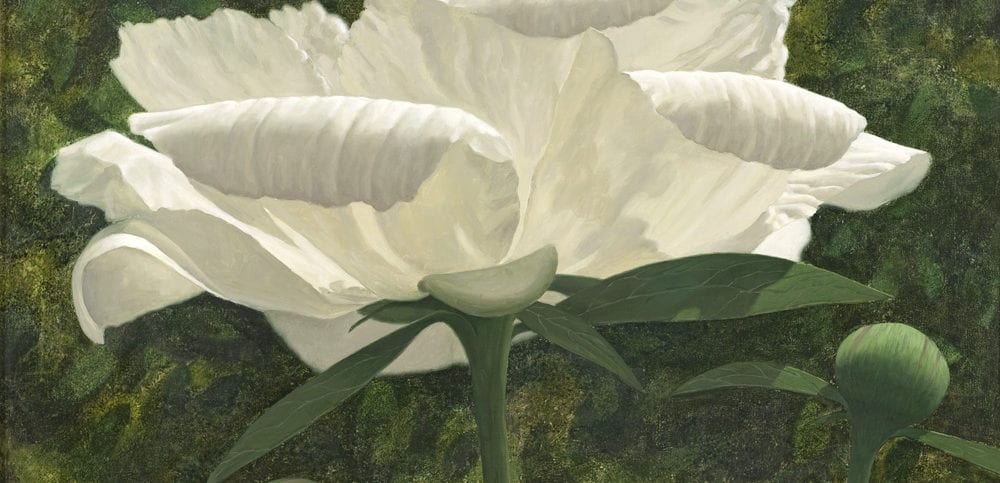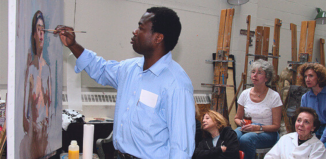By Susan Risoli
The poet/artist William Blake wrote of seeing “a World in a Grain of Sand, and a Heaven in a Wild Flower” and holding “Infinity in the palm of your hand, and Eternity in an hour.” The Reboli Center for Art and History will consider the ways different artists see not only wildflowers but landscape in all its elements, through its latest exhibit In Bloom, which opens May 2.
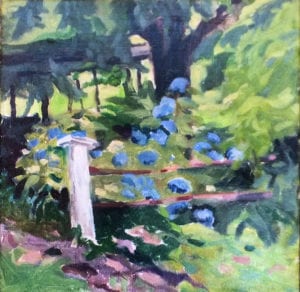
The show features paintings by Joseph Reboli and Ty Stroudsburg’s paintings and pastels. Although Reboli was known for classical realism and Stroudsburg works in a more abstract, less representational way, the artists knew and admired each other, said Lois Reboli in a recent interview. “The exhibit will be a riot of color,” she said, as her late husband’s work is presented side-by-side with Stroudsburg’s.
The Reboli Center opened this past fall to preserve the legacy left by Joe Reboli, a well-known painter and longtime Three Village resident who died in 2004. Every exhibit will show his paintings together with work done by someone he knew.
Stroudsburg will show 12 pieces in the In Bloom exhibit. Some are framed oil paintings on paper, others are oils on linen canvas and the rest are framed pastels. Although she and Reboli shared the same birth date (Sept. 25) and a love of landscape, they respond to their environments differently.
Lush abstraction
“The first thing I deal with is color,” Stroudsburg said in a recent interview. “I just love it.” Her slashing brushwork (“people have called it ‘Zorro-esque’”) grew from her abstract expressionist work done in the 1960s. “I love to experiment with what the paint can do,” Stroudsburg explained.
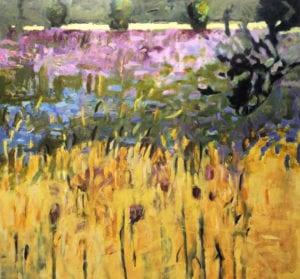
When it comes to interpreting light, “I don’t use it in terms of light and shadow. But obviously, without light there’s no color, so it’s there.” Areas of lush color lead the eye around her pieces, as one takes note of the forms and textures Stroudsburg uses to interpret what she called the “natural, unpopulated world.” The result, she said, is “an effort to record the pervasive qualities of places that excited my vision. In this way, hopefully, the viewers of my work will be able to share that vision.”
Stroudsburg is a self-taught artist who started her career as a teacher. “I lasted three weeks,” she said wryly. A 1962 trip to Long Island changed her life. Inspired by the Parrish Museum, Guild Hall and then-rural South Fork, “I got a part-time job in a dress shop, just continued to paint and that was it,” she recalled. Stroudsburg lives in Southold now, where the North Fork’s farm fields and changing seasons “are a big point of takeoff” for her art.
Yin versus Yang
Presenting Stroudsburg’s landscapes alongside Reboli’s demonstrates how artists can see the same subject with different vision, said Colleen Hanson, co-director of the Reboli Center with Lois Reboli and B.J. Intini. In Stroudsburg’s and Reboli’s interpretations of nature, “you have this kind of yin/yang painting of Long Island. Both are known for color and light, but Ty is abstract and Joe used classical realism.”
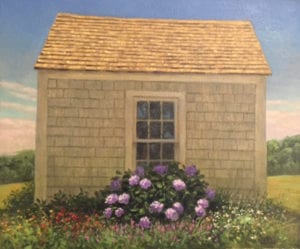
Sunlit vegetables that almost seem to glow from within, spirited hydrangeas staking their claim against the wall of an old cottage, Stony Brook Village blanketed with snow — all are rendered with Reboli’s attention to light and shadow, and his devotion to interpreting the hallmarks of a season.
“In the 1960s, when Joe went to the Paier School of Art, there was a huge abstraction push” in the art world, Hanson said. “Many schools were deviating from a classical education component” but Reboli embraced and excelled in the tradition. In Stroudsburg’s painting, “Ty’s strokes are looser, the composition is looser. Her work has that color field and movement that just engages you.”
Showing Reboli’s art next to the work of other artists gives people “a way to understand how different origins make for different paintings,” Hanson said. “What we’re trying to do is explore Joe’s origins and his references. We show the contrast with painters who were in the same area at the same time, doing the same subject.”
Third Friday talks
The Reboli Center’s monthly Third Friday talks from 6 to 8 p.m. link the local community with its history, said Lois Reboli, while at the same time focusing on aspects of the exhibits.
On May 19, the center will welcome Christina Strassfield, museum director and chief curator of Guild Hall Museum in East Hampton, who will speak about “My Life in Museums,” a life and career shaped by art.
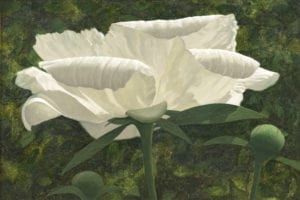
On June 16, Deborah Johnson, deputy director and director of development at the Heckscher Museum of Art in Huntington and author of a book titled “Joseph Reboli,” will speak about Reboli’s work.
On July 21, Katharine Griffiths, director of Avalon Park and Preserve, will discuss the park’s use of native plants. Reboli’s mother Olga Jicinsky Reboli was born and raised in “a little tiny house” that eventually became the renovated building where Avalon Park staff are headquartered, Lois Reboli pointed out.
Third Fridays are a chance for people to gather for stimulating discussion and “a wonderful, fun evening,” Reboli said. “We’re pretty much packed every time we have one.” The talks are free and light refreshments will be served.
The Reboli Center for Art and History, 64 Main St., Stony Brook will present In Bloom from May 2 through July 30. An artist reception is yet to be scheduled. The center is open Tuesdays through Saturdays from 11 a.m. to 5 p.m., and Sundays from 1 to 5 p.m. For more information, call 631-751-7707 or visit www.rebolicenter.org

